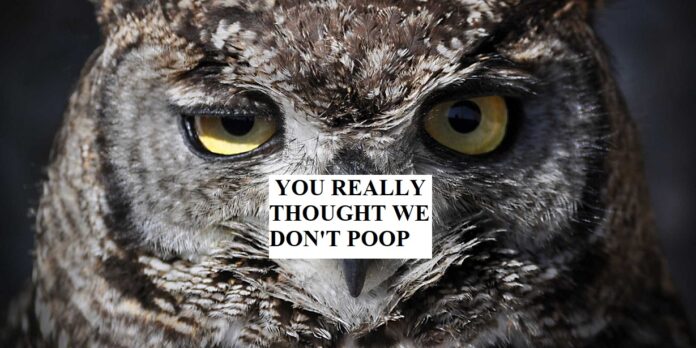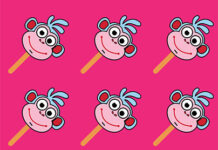Do Owls poop, you ask? Yes, owls do poop. Like all birds, they have a cloaca, a muscular pouch that is the common opening for the intestinal, urinary, and genital tracts. When an owl needs to defecate, it will excrete waste material and feces through the cloaca.
Owls infrequently defecate, as they have a high metabolism and can extract a lot of nutrients from their food, so there is little waste material to excrete. However, when they defecate, it is usually in the form of small, pellet-like droppings made up of indigestible matter such as bones, fur, and feathers.
I had to clean poop off my car when my pet owl stained it, the smell was horrible, maybe because he ate 2 mice last night lol.
How Often Do Owls Poop?
The frequency of owl poop depends on the owl species, diet, and general health. In general, owls tend to defecate infrequently, as they have a high metabolism and are able to extract a lot of nutrients from their food.
This means that there is not much waste material to excrete. However, some species of owls may defecate more frequently than others, depending on their diet and other factors.
For example, barn owls, which primarily eat rodents, may defecate more frequently than other species of owls, as they have a higher protein diet.
On the other hand, species of owls that primarily eat insects may defecate less frequently, as insects are easier to digest and produce less waste.
It is also worth noting that owls may defecate more frequently when young, as their bodies are still developing and may have a higher metabolism. As they mature, their poop frequency may decrease.
Overall, the frequency of owl poop can vary widely depending on the species and individual factors. It is common for owls to go several days or even weeks between defecating.
Owl poop, or feces, is produced when an owl digests its food and excretes waste material through its cloaca. The frequency of an owl’s poop varies depending on its size, diet, and overall health.
Generally, smaller owls may defecate more often than larger ones, and owls that eat a diet high in protein, such as rodents, may defecate more frequently than those that consume insects.
Owls often release undigested material in the form of pellets made of indigestible matter such as bones, fur, and feathers.
These pellets can take several hours to form after the owl has eaten and can remain in the proventriculus, a part of the digestive system, for up to 10 hours before being regurgitated.
The texture and shape of the pellets can vary depending on the size and species of the owl and the prey it consumes.
Environmentalists and scientists often study owl pellets to learn about the diet of these birds, and the dissection of pellets is a common activity in schools.
How Do Owls Poop?
Owls have a unique digestive process due to their ability to consume their prey whole. The proventriculus, a part of the digestive system, contains enzymes, mucus, and acid that help to break down food.
The gizzard, or ventriculus, separates the prey’s soft, digestible parts from the indigestible parts.
The soft, digestible material is absorbed into the bloodstream through the small intestine, while the indigestible material is compacted and formed into pellets.
These pellets remain in the proventriculus until the owl is ready to regurgitate them, at which point they pass through the esophagus and are ejected through the beak.
Owls excrete waste in two ways. The digestible parts of the prey are eliminated through the cloaca, also known as the excretory opening or vent.
The indigestible parts are regurgitated in the form of pellets, which are made up of undigested material such as bones, fur, and feathers.
Like most birds, owl feces are white in color due to the presence of uric acid, which is similar to urine. However, the color of an owl’s feces may vary depending on its diet and other factors.
Pellets should not be confused with feces, as they are not excreted similarly.
Pellets are not digested and do not contain the excretive acids in feces. Instead, they are more similar to vomit in that they are produced when the owl expels undigested material from its digestive system.
ALSO CHECK: SURPRISING FACTS THAT WILL BLOW YOUR MIND
What is the Color of Owls Poop?

The color of an owl’s poop, or feces, may vary depending on its diet and other factors. In general, however, owl feces is white due to the presence of uric acid, which is similar to urine.
This is a common characteristic of bird feces, as birds produce a waste called urates, which are made up of nitrogenous waste products such as uric acid.
It is worth noting that the color of an owl’s feces may vary depending on the specific diet of the individual owl.
For example, an owl that consumes a diet high in protein, such as rodents, may produce more yellow feces due to the presence of bilirubin, a pigment produced by the breakdown of red blood cells.
On the other hand, an owl that primarily eats insects may produce feces that are lighter in color due to the lower protein content of its diet.
Overall, the color of an owl’s feces can vary widely depending on its diet and other factors and may range from white to yellow or even green in some cases.
It is not uncommon for the color of an owl’s feces to change over time as its diet and other factors change.
ALSO READ: Surprising Facts About Bat Poop
Owl Pellet
Owl pellets are compacted masses of indigestible material, such as bones, fur, and feathers, that owls and other birds of prey produce.
They are formed when the owl separates the soft, digestible parts of its prey from the indigestible parts in the gizzard, or ventriculus, of its digestive system.
The indigestible material is compacted and formed into a pellet, which remains in the proventriculus, a part of the digestive system, until the owl is ready to regurgitate it. Pellets are then ejected through the oesophagus and beak.
The size, shape, and texture of owl pellets can vary depending on the species of owl and the prey it consumes. For example, barn owl pellets are typically the size of a man’s thumb and are smooth, dark, and cylindrical.
On the other hand, great horned owl pellets are larger, measuring 3-4 inches in length, and are tightly compact and cylindrical.
Pellets from smaller owl species, such as elf owls, may be smaller and more irregularly shaped, with a dry, loose texture due to their diet of insects.
Owl pellets are often used by scientists and environmentalists to study the diet of these birds, as they contain a record of the prey that the owl has consumed.
Dissection of owl pellets is also a common activity in schools, as it allows students to learn about the anatomy and biology of these birds.
An Owl’s Digestive System Overview
Owls have a unique digestive system that allows them to consume their prey whole and extract as many nutrients as possible from their food. The process begins when the owl captures and consumes its prey, which is typically small mammals such as rodents or birds.
The first part of the digestive system is the esophagus, a muscular tube carrying the food from the beak to the rest of the digestive system.
The food then enters the proventriculus, a part of the digestive system that contains enzymes, mucus, and acid that help break down the food.
The gizzard, or ventriculus, is the next part of the digestive system, and it serves to separate the soft, digestible parts of the prey from the indigestible parts.
The soft, digestible material is passed down to the small intestine, absorbed into the bloodstream, and used as energy by the owl.
The indigestible parts of the prey, such as bones, fur, and feathers, are compacted and formed into pellets, which remain in the proventriculus until the owl is ready to regurgitate them. The pellets are then ejected through the esophagus and beak.
Finally, the digestible parts of the prey are eliminated through the cloaca, which is a muscular pouch that serves as the common opening for the intestinal, urinary, and genital tracts. This is also where the owl’s feces, or poop, is excreted.
Overall, the digestive system of an owl is highly efficient at extracting nutrients from its food and eliminating waste material, which is essential for the bird’s survival in its natural habitat.
Conserving Owls
Owls are a diverse group of birds that are found on every continent except Antarctica. While some species of owls are common and not considered to be at risk, others are threatened or endangered due to habitat loss, human disturbance, and other factors.
There are several ways that conservationists and organizations are working to protect owls and their habitats. These efforts may include:
- Habitat protection: Protecting and preserving natural habitats is important for the survival of owls and other wildlife. This can involve creating protected areas, such as national parks or wildlife reserves, or working with landowners and communities to manage land in a way that benefits owls and other species.
- Research and monitoring: Studying owls and their habitats can provide valuable information about their behavior, biology, and ecological needs. This knowledge can be used to inform conservation efforts and to identify potential threats to the species.
- Education and outreach: Educating the public about the importance of owls and their role in the ecosystem can help raise awareness and encourage conservation efforts. This may involve working with schools, community groups, and other organizations to promote conservation and responsible wildlife viewing.
- Species recovery programs: Some species of owls are at risk of extinction and may require targeted conservation efforts to ensure their survival. This may include captive breeding programs, habitat restoration projects, and other efforts to support the recovery of the species.
Overall, conservation efforts are essential for protecting owls and their habitats and can help to ensure the long-term survival of these fascinating and important birds.
Do Owls Poop – CONCLUSION
In conclusion, owls produce feces, or poop, like other animals, to eliminate waste from their digestive system. The frequency of an owl’s poop can vary depending on its size, diet, and overall health. Owls also produce pellets, which are compacted masses of indigestible material such as bones, fur, and feathers. These pellets are produced when the owl separates the digestible and indigestible parts of its prey in the gizzard, or ventriculus, of its digestive system.
Pellets are regurgitated through the esophagus and beak and are not considered to be feces. The color of an owl’s feces may vary depending on its diet and other factors and may range from white to yellow or even green in some cases. Understanding owls’ digestion and excretion processes can provide valuable insights into the biology and ecology of these fascinating birds.




